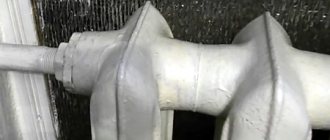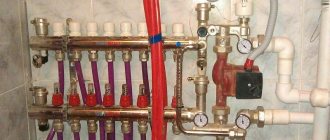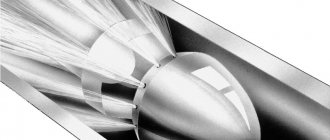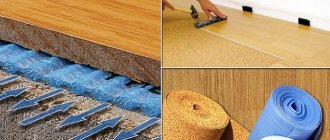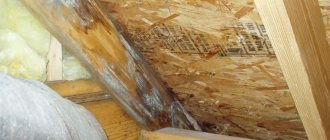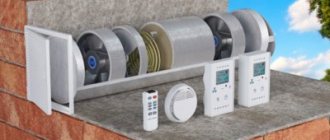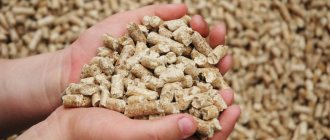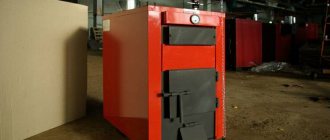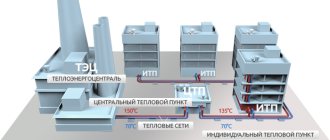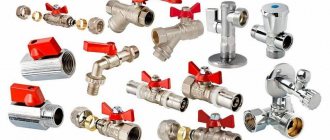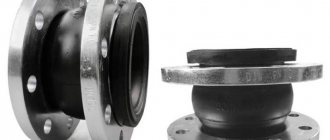Pneumatic and hydraulic pressure testing of pipes: how it is done
Pressure testing of a pipeline is a technological operation performed on a relatively small isolated section of the pipeline. This section is specially tested by applying high pressure, close in value to the maximum permissible. Carrying out pressure testing of pipelines allows you to verify the integrity of the line, the quality of installation work and installation of fittings.
Pressure testing is a necessary and important operation that allows you to identify weak points in the assembled pipeline
The concept of pipe crimping
Pressure testing means checking the readiness of an object for operation by applying increased pressure. The object of such a check may be a pipeline system, a container, an assembly or machine, or a separate mechanism. When we talk about increased pressure, we mean a value that is 2-3 times higher than the working pressure and is close to the maximum permissible. An object that has successfully passed pressure testing is considered suitable for use. Leaks identified during the inspection are repaired.
Important! The amount of pressure during pressure testing is regulated by regulatory documents for certain groups of objects.
Pressure testing must be carried out by a trained specialist. Relevant employees of industrial and utility enterprises are required to undergo certification. Upon completion of the tests, a report is signed indicating the date, pressure value, holding time and other information.
The pressure in the system for testing is created either by a standard pump or a special pressure tester. They check, as usual, with water. When its use, for some reason, is unacceptable, air pressure testing of pipes is carried out, which makes it difficult to detect leaks.
When is pressure testing of pipelines carried out?
All new pipeline systems, tanks, etc. are subject to pressure testing before putting into operation. All objects that have undergone repair or replacement of some element are also checked. Since the joints with installed fittings are considered to be the most unreliable sections of the pipeline, sections where coupling was used are subject to mandatory inspection.
All types of pipelines, domestic and industrial, newly built and already in operation are subject to pressure testing
Testing is also carried out in other cases:
- if the pipeline has been idle for a long time or operates in seasonal mode (like a heating system in the summer);
- if scheduled inspections are provided. In this way, the polymer sewer system is checked when the integrity of the outlet pipeline is monitored. Pressure testing of a plastic water supply is one of the most popular operations carried out after any pipe cleaning, since mechanical damage is very likely, especially at the joints;
- after flushing the pipeline, especially with the use of aggressive chemicals, which could cause damage to fittings or pipe walls;
- Wells are tested in a special way - to check whether perched water (water from the surface layers) gets into its shaft, because consumers are concerned about the quality of water, especially drinking water.
Preparation for work
Carrying out pressure testing is a responsible procedure that requires preparatory measures. Before starting pipeline testing, it is mandatory to:
- An inspection is carried out to identify visually detectable defects (corroded areas, missing parts, etc.). If violations are identified, they are eliminated. In cases where the system contains a working medium that is prohibited from being used for testing, it is customary to empty it (for example, the heating system is freed from coolant).
- The pipes are washed to remove rust, scale, and deposits of organic and inorganic origin. Some of the flushing methods require the use of a compressor. Upon completion of washing, the quality of its implementation is checked. The quality of flushing is checked by the condition of the inner surface of a half-meter section of the pipeline cut out at a randomly selected location.
To carry out work, a pressure gauge must be installed on the equipment to control the pressure.
If the injection device does not include a check valve that retains the working medium in the system, and a pressure gauge, then they are installed after completion of the tests.
It is important to know! Pressure testing of the heating system of an apartment building precedes an inspection of the work on preparing the associated heating unit. This is explained by the fact that the thermal unit is checked using high pressure values.
Purpose and application
Pressure testing is carried out using liquid. This may be water or oil, depending on the type of hydraulic system. By filling the communication system with liquid under a certain pressure, it is possible to determine the condition of the pipeline and equipment, evaluate its technical capabilities and eliminate identified defects. This procedure allows you to avoid extremely unpleasant, and sometimes even unsafe for human life and health, emergency situations. Carrying out preventive measures allows you to quickly, carefully and with minimal material and financial costs maintain the technical condition of communications at the proper level.
SNiP and safety measures during crimp testing
The procedure for testing pipelines, technological diagrams of the pressure testing process and safety standards are determined by the relevant sections of SNiP:
- for internal sanitary systems - SNiP 3.05.01-85;
- for external drainage systems - SNiP 3.05.04-85;
- for heating, ventilation and air conditioning systems - SNiP 41-01-2003.
Industry regulations define the procedure for performing pressure testing on industrial pipelines.
The specified documents establish the pressure values permissible during testing. This value is determined by the material of the pipes, the minimum thickness of their walls, the difference in height between the lower and upper elements of the system under test and other factors. When conducting hydraulic and pneumatic tests, the pressure value can be (in atm):
- for pressure pipelines of water supply systems – 10-15;
- for cast iron sewerage – 1.5;
- for non-pressure polymer pipelines – 1.5 – 2;
- for heating systems of apartment buildings where cast iron radiators are installed - 2-5 (but not less than the value exceeding the operating pressure by 1.5 times);
- for input nodes of centralized systems – 10;
- for private houses - 2 (since the emergency valve is usually set to this level).
Pressure testing must be carried out in accordance with SNiP, taking into account the type of main line and the material of the pipes installed in it
Important! When conducting tests, the main safety requirement is to adhere to the recommended pressure limit. To avoid unpleasant consequences, it is recommended to use a crimping machine equipped with a special limiter when conducting tests.
Crimping technology
When hydraulically testing pipes, the pipeline system under test is loaded with internal pressure, which should be 1.5 times higher than the nominal pressure. The duration of the tests depends on the technological purpose of the system:
- heating pipes are kept for 40...60 minutes;
- steel lines through which hot or cold water is supplied – 3…4 hours;
- industrial pipelines - up to 8 hours;
- metal-plastic pipes - according to the manufacturer's recommendations, but more than 15 hours.
The system is considered pressure tested if the permissible drop in compression in the pipes (or lack thereof) remains unchanged for a specified period of time, while there is no deformation, high humidity or, for gas pipelines, a characteristic whistle on the outer surface of the pipes.
General procedure for conducting pneumatic and hydraulic tests
The testing scheme for air and water is general. The procedure is as follows:
- Within the test object, a part of it is isolated and closed using shut-off (regulating) valves (the sewer pipes are plugged with rubber plugs or wooden plugs wrapped in rags).
- The test object is filled with water. When testing heating systems, when filled with water, air is discharged through special air vents in the upper part.
- A pressure tester is connected to the system, pumping a certain amount of working fluid to create the pressure required by regulatory standards.
- Having reached the required pressure value, recorded by the observer on the pressure gauge, the pressure tester turns off.
- The system is left under pressure for a certain time (for heating systems - at least half an hour; in some cases, the holding time can be 6-8 hours).
- At the end of the designated holding time, the observer again takes the pressure gauge readings. A difference in pressure gauge readings is evidence of a leak in the system that needs to be detected and eliminated.
Pipe crimping technology
Before you begin directly carrying out work using a pipe crimper, it is important to carry out a number of preparatory measures:
- inspection of the system under test to detect obvious defects, for example, missing parts, rusted areas;
- troubleshooting detected problems;
- if the system under test is filled with a substance, for example, coolant, it must be emptied;
- flushing the pipeline is another important stage of preparation, which allows you to remove rust from the pipes, as well as various types of deposits (special compressors are used for thorough flushing);
- The final stage of preparatory work is the installation of a pressure gauge, which is often included in the package of a pipe pressure tester.
When all the preparatory work has been completed, you can proceed directly to pressure testing of the pipeline. The general scheme looks like this:
- The area of the system that will be tested is reliably isolated. To do this, shut-off or control valves are closed, and sewer pipes are closed with reliable plugs.
- The prepared system is completely filled with water. If the heating system is checked, air is completely discharged through the air vents.
- A pipe pressure tester is connected to the pipeline to pump in working fluid and achieve a certain pressure level. During the process of pressurization, data is recorded - readings on the pressure gauge.
- After the above manipulations, according to the rules, the system must be left under pressure for a certain time, which depends on the type of pipeline. For example, one hour is enough for a heating system; other piping systems may require six to eight hours.
- The final stage is re-taking readings from the pressure gauge. If the pressure deviates from the original value, then there is a leak in the system that needs to be identified.
Pressure testing of pipelines with air and water
To test the performance of a heating, water supply or sewerage system, you will need a pump (special or one that circulates liquid in the system). It is connected to the heating system either:
- directly to the tap designed to drain the working fluid from the heating system;
- to any of the radiators. To do this, the Mayevsky tap is removed, and in its place an adapter is installed, to which the hose from the compressor is connected.
The water supply test is carried out through the connection pipe of the taps through which cold or hot water is supplied. To connect to the sewerage system, you will need to insert the sediment fitting into one of the revisions, special tees mounted in the outlet pipeline every 40-50 m.
Purchasing a crimping machine for personal use that will be used once a year is hardly advisable. Which pump to use to pump air or water into the system is determined based on the pressure that needs to be created for the test (and it should be 2-3 times higher than the working pressure). To pressurize the heating system of a private household, a car compressor or an electric pump should be sufficient.
Source
Pressure testing of water supply and heating systems - how is it done?
As a rule, the process of monitoring the integrity of pipes and the quality of joints using the crimping method can be implemented in the process of performing the following actions.
Action one: covering and sealing the controlled area. At this stage, we cut off the pipeline branch to be pressure tested from the central line of the water pipeline. To do this, you need to shut off the shut-off valves (taps or valves) at the end and beginning of the section. Well, for sewers, special plugs made of plastic, rubber or wood are used.
Step two: connecting to the controlled area a source that pumps pressure. Moreover, either a special pump for pressure testing pipes or a conventional pump responsible for circulating fluid in the system is used as such a source.
The pressure source (pump) is connected to a special outlet (pipe), the presence of which was provided for during the pipeline design process:
- Pressure testing of the heating system is carried out using special taps attached to each battery,
- the water supply can be pressurized through the connection pipe of the hot or cold water tap,
- with sewerage it is even simpler - the sediment fitting is inserted into the inspection - a special tee mounted in the outlet pipeline in increments of 40-50 meters.
The accuracy of the results and operating time depend on the power of the pump. After all, a low-power pump will increase the testing time - a simple pipe crimper will not be able to quickly fill a large pipe with the required volume of air, and a leaky joint will distort all the results of our tests.
Therefore, pumps for pressure testing must be selected based on the volumes of the pipelines being tested. So, for a home system, a supercharger that pumps a couple of liters per minute through itself will be sufficient. Well, pressure testing of heating mains involves the use of circulation pumps, which are responsible for the flow of fluid in the system, as a supercharger.
Step three: pumping air (water) and monitoring the stability of pressure in the system. At this stage, a decisive action occurs - water or air is pumped into the system through the injection pump. Moreover, the injection occurs through a back pressure valve, which does not allow water (air) to move in the direction opposite to the direction of injection.
The value of the “control” pressure depends on the pipe material. Cast iron products are tested with a pressure of 1.5 atmospheres, free-flow plastic pipes with a pressure of 1.5-2 atmospheres, and pressure pipes with a pressure of 10-15 atmospheres.
Moreover, the pressure in the pipe itself is controlled both during the 8-hour “holding” and during the injection of air (water) into the pipe. The main measuring tool, in this case, is a conventional pressure gauge. The test results are taken from the scale of this device.
Of course, the pressure gauge must be located behind the back pressure valve, otherwise you will not see any results.
Pressure testing with air and water - what is it?
Pipeline pressure testing refers to operations that control the integrity of the line and the quality of installation of pipes and fittings. This operation is performed on a relatively small section of the pipeline, which is isolated from the main line and subjected to an elevated pressure test bordering on the permissible one.
Pressure testing of sewerage, water supply or heating system pipes is carried out by pumping a large volume of compressed air or cold water into a separate “branch”, creating a pressure close to critical in the pipeline.
And if the system passes this test and maintains its tightness, then the pipeline is considered suitable for further operation. If the system does not hold up, and a breakthrough is detected in a weak link, which is detected by a pressure drop on the pressure gauge, then the entire tested branch is sent for revision.
When is crimping necessary?
It should be noted that all new pipelines (before commissioning) and some old systems (testing after repair) are subjected to this test. In addition, all systems that were installed using the coupling method are subjected to pressure testing. After all, the junction of a pipe and a fitting is a traditionally weak section of the pipeline structure.
Another reason for performing a pressure test is the seasonal operating mode.
pipeline. For example, before starting central heating, all sections of the heating main and heating system of an apartment building are checked by pressure testing.
Pressure testing of plastic sewerage is an equally popular operation: after all, it is performed both periodically (to monitor the integrity of the outlet pipeline) and one-time (after each pipe cleaning). Moreover, the latter option is very relevant - after all, during the cleaning process, either the pipe itself or the place where the pipes are joined can be damaged.
Another version of the control operation - pressure testing of water wells - is performed according to slightly different rules. After all, the pipe in the well shaft is already in the water from the very beginning, therefore, there is no point in fearing leaks from such a pipe.
